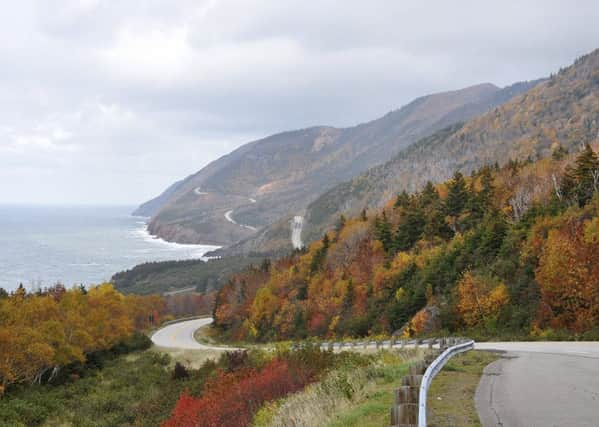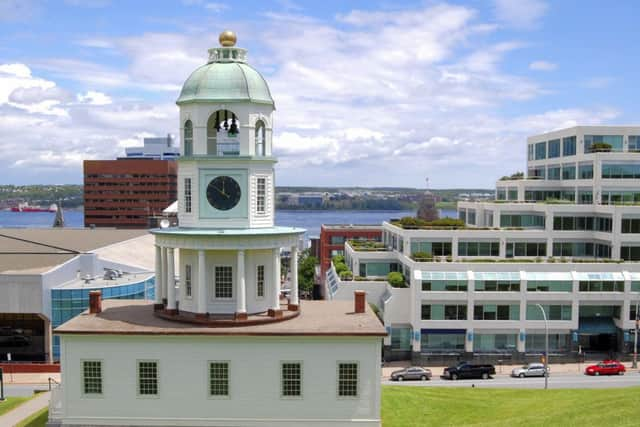Travel: Nova Scotia is old country writ large


‘WHOA! Alex! Watch out!” An enormous white lumber lorry from the docks is coming up the road and my friend has just stepped out in front of it.
He turns round and smiles as the lumber lorry slows down to let him cross the road.
“But you could’ve been killed!” I splutter.
Advertisement
Hide Ad

“Toronto, certainly. Montreal, maybe,” he replies. “But this is Halifax. You can do this here.”
Halifax, Nova Scotia. Where lorries are petrified of people.
You’d recognise bits of Britain in it: the Victorian bandstand in the park, the neatness of the floral clock, the sign next to the tree that the Queen planted when she came on a visit with her father in 1939. The Union Flag on top of the Citadel. Bagpipes, soldiers in kilts. War memorials with battles we know about. The profusion of real ales: a pub called The Maxwell’s Plum boasts 90 different ones on tap.
It’s my last night in Nova Scotia, and Alex and I had been working our way through some of them. I’d been travelling round Cape Breton, and he wanted to know what I’d seen. I hand him my itinerary. He reads it, nodding.
“You’ve seen a lot in a short time. What did you make of it?”
I probably gush a bit, because everything has been perfect. I’d been travelling in a heatwave, almost as rare there as here. Everywhere I went, volunteers were putting on a festival or getting ready to put one on. I watched them all go by: the Mardi Gras Parade at the Pictou Lobster Carnival; one at Port Hawkesbury that I just stumbled on in which half of the population had gathered to cheer the other half; the girls’ tug o’ war competition at the Antigonish Highland Games; the genteel gathering at the Read by the Sea free book festival. None were slickly sponsored or put together by officialdom or deliberately for tourists. I was hugely impressed.
Advertisement
Hide Ad“Did I pick up on the poverty?” Alex asked. No. “On the lack of jobs?” No – maybe I wasn’t looking hard enough. Even in Inverness, a former mining town (it’s fictionalised as Shean in the excellent novels by Frank Macdonald), the old shale bings had been landscaped away into the only links course on the whole of the North American east coast (the accompanying hotel has – and this is a new one on me – free international phone calls). Trump should have saved his money, I thought, or pumped it into Nova Scotia rather than Scotland: at least in the Canadian Inverness, looking west, you can get spectacular sunsets over the sea.
Even a run-down former mining town like Inverness looked fine enough to me, with company houses built for the miners at least twice the size of anything you’d ever find in a British pit village. “Some are,” Alex admitted, “and if they’ve got someone out west in Alberta, they’ll have a split-level floor and a TV half the size of the wall and an SUV and motorboat out front. But there’s too few jobs for them here.”
Advertisement
Hide AdTourists have it easier. A lot easier. “As one Scotchman to another, can I buy you a beer?” says a local who has caught my accent at a Cape Breton bar. And yes he could: I’ve grown rather partial to boutique Canadian beers. There was a ceilidh going on in the background – this place is on the tourist-mapped “ceilidh trail” (memo to VisitScotland: shouldn’t we be doing this?) – and we get talking. How many of the dancers are local, I ask him, and he replies that most of them are, “but by local I mean mebbe 50 miles away”.
At the top of Cape Breton, I go on another trail. The John Cabot Trail through the 950 squares kilometres of the Cape Breton National Park is meant to be one of the most photogenic drives in the world. For 72 miles it twists along on cliff tops, swooping down river-cut canyons to the Gulf of St Laurence and climbing up to the top of an ice-flattened plateau on which you can drive for uninterrupted miles across bogs and lakes and primeval forests. Somewhere out there, promises the guidebook, are moose, black bear and coyote (“If a coyote attacks,” it warns, “shout, throw stones and use whatever is available to defend yourself”). But it’s not just a wilderness drive: with 26 hiking trails off it, and a full range of activity suggestions at the excellent visitor centres, it is also the best organised national park I’ve ever seen.
“Was that the best thing about Nova Scotia?” Alex asks, and the past week runs through my mind. The ceilidh dancing at Judique? Lobster Benedict at Pictou Lodge? The view from the veranda at the Chanterelle Country Inn? The eroded rock formations at the Bay of Fundy? The “white glove” tour at the Alexander Graham Bell museum at Baddeck, where you are told about – and are allowed to touch – some of the artefacts not on public view? What’s going to linger longest?
Three things, I think. For someone from this tiny crowded island, I think it’s always good to travel somewhere you can get that sense of enormous space, in a landscape where nature dominates so completely.
That’s easy almost anywhere in Canada, so I’ll add a second one: filling in the gaps in one’s knowledge of the past. Oddly, perhaps, I’m now hooked on the history of Canada before it became Canada, long before the British built up Halifax into one of just four key naval bases in their empire. A city from which 17,000 ships sailed to help us in the Second World War and to which 34,000 war brides returned afterwards. A city where a British stranger can still feel very much at home.
Thirdly, it’s the only city I’ve been in where lorry drivers have perfect manners and stop for pedestrians at all times. But just in case I’m wrong, please don’t test it out for yourself.
Advertisement
Hide Ad• David Robinson travelled to Nova Scotia on an Icelandair flight from Glasgow to Halifax via Reykjavík. For further ideas about holidays in Nova Scotia, please see www.novascotia.com and www.keepexploring.ca